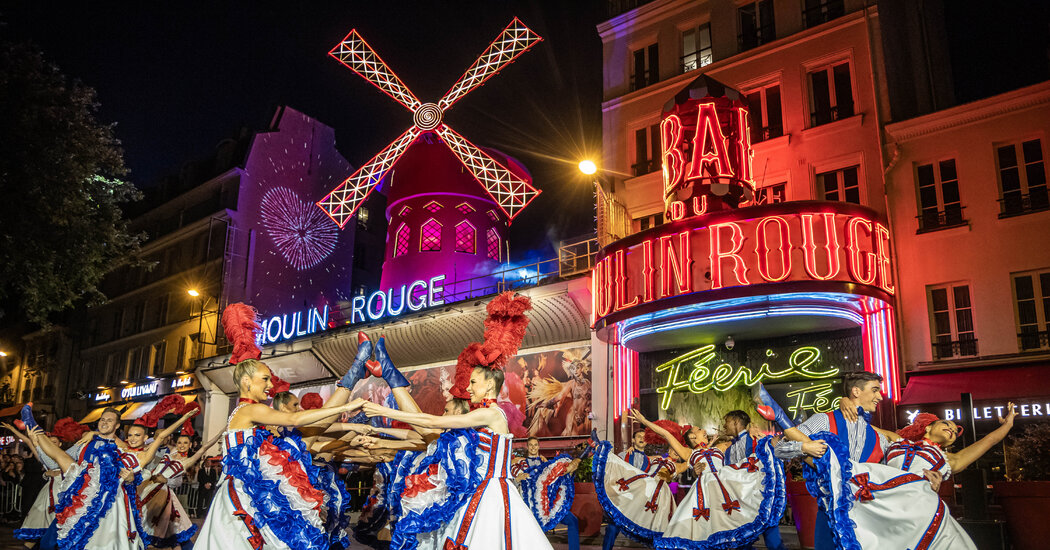The moulin is back. The rouge never left.
The Moulin Rouge, the famed Paris cabaret, has restored its iconic windmill after its blades broke and fell to the ground in April. The construction was finished weeks before the Paris Olympics are set to begin — and before the flame passes by on its relay route through Paris on July 15.
“We wanted to be ready for this special moment,” said Jean-Victor Clerico, the managing director, whose family has run the cabaret since 1955, adding, “The Moulin Rouge without the blades? It’s not the same.”
The cabaret, whose name means “red windmill” in French, has stayed open through the repairs. But it had stood functionally topless since April, when parts of the lettering also fell. No one was injured; a spokeswoman blamed a mechanical problem.
Sympathy poured in from around the world, Mr. Clerico said. Fans sent in letters of support, he said. Some even wrote poems. For two months, the Moulin Rouge raced to remount the aluminum blades, pushing a metalwork company to work quickly to meet their deadline.
Finally, right on schedule, the cabaret celebrated its full return to glory on Friday evening with a street show. As the bright neon lights on the windmill flicked back on, a crowd of about 1,500 people burst into cheers, Mr. Clerico said.
Dancers performed the cancan — an emblem of the city, and of the cabaret culture epitomized by the Moulin Rouge — in blue, white and red costumes. They yipped and kicked, rustling their ruffles and shaking their skirts. Mr. Clerico said that the outdoor show was only the second time that the cabaret put on a cancan on the street. (The first was on its 130th anniversary in 2019.)
“There was a lot of pressure since the last two months to be ready,” Mr. Clerico said. “But a lot of people were happy to see the blades back.”
The restoration, however iconic, is one small part of Paris’s dash toward the Summer Games.
Venues are ready, but the Seine may still be too dirty for swimmers. Obstacles remain for people with disabilities. And Parisians have even taken to social media to warn tourists to stay away, fretting about overcrowded transportation and a city overwhelmed by millions of visitors. All the while, the country, which was voting on Sunday, is mired in political uncertainty.
But the Moulin Rouge has seen Paris through other difficult chapters in its history.
The venue opened in 1889, and quickly became a hub for artists and writers in the bohemian 18th arrondissement. It stayed open through world wars and waves of gentrification.
“It’s a symbol of life. It’s an icon,” said Gabriel P. Weisberg, a professor emeritus of art history at the University of Minnesota and the editor of “Montmartre and the Making of Mass Culture.”
Over its 135 years, the Moulin Rouge has inspired artists from Henri de Toulouse-Lautrec, whose paintings helped put it on the map, to Baz Luhrmann, whose 2001 film (“Moulin Rouge”) dusted off its racy mystique for modern audiences. In 2021, a theatrical adaptation of the film even won a Tony Award for best musical.
The building itself is not only a landmark, said Richard Thomson, an art historian at the University of Edinburgh who focuses on late 19th-century French art. It is also something of metaphor. If Notre Dame represents religion in Paris, and the Eiffel Tower is an expression of the city’s modernity and embrace of ambitious technological experimentation, the Moulin Rouge is a standard-bearer of popular entertainment.
“It suggests a racy part of Paris, a slightly degenerate part of Paris, but an exciting one,” Professor Thomson said.
The venue been damaged before, most notably in 1915, when a fire ravaged it. The cabaret was closed for nearly a decade. But then, as the Moulin Rouge always had, it reopened.
“It became a symbol for the city of Paris and a symbol of a way of life,” Dr. Weisberg said, adding, “There was a sense of freedom that these artists and poets, writers and dancers were able to achieve at the Moulin Rouge.”
“That’s very important: freedom,” he added. “The French are good for that.”
